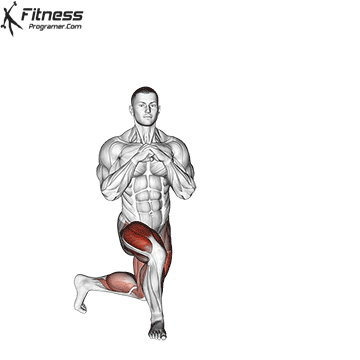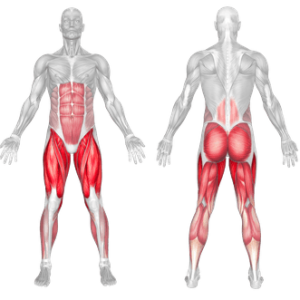Overview
The curtsy squat is a lower-body exercise that effectively targets the glutes, quadriceps, and inner thighs while also improving balance and coordination. This movement mimics the motion of a curtsy, making it a unique lunge variation that engages stabilizing muscles and enhances lower-body strength.
How to Perform the Curtsy Squat

Step 1: Setup and Positioning
Stand tall with your feet hip-width apart and keep your core engaged.
Clasp your hands on your hips or in front of your chest for balance.
Step 2: Execution
Step your right leg diagonally behind your left leg, lowering your hips into a squat position.
Keep your front knee aligned with your toes and lower your back knee close to the ground.
Press through the heel of your front foot to return to the starting position.
Repeat on the opposite side and continue alternating legs.
Tips for Proper Form
Keep your torso upright to avoid unnecessary forward lean.
Engage your core to maintain balance and stability.
Ensure your front knee stays aligned with your toes to prevent strain.
Use a slow and controlled motion, focusing on the mind-muscle connection.
Start with bodyweight before adding resistance like dumbbells or kettlebells.
Common Mistakes to Avoid
Leaning too far forward, which can reduce glute activation and strain the lower back.
Not stepping far enough behind, limiting the range of motion and effectiveness.
Allowing the front knee to cave inward, leading to improper alignment.
Using excessive weight before mastering the proper form.
Rushing through reps, which can reduce stability and muscle engagement.
Benefits of Curtsy Squat
1. Targets Multiple Muscle Groups
The curtsy squat effectively engages the glutes, quadriceps, hamstrings, and adductor muscles. This makes it a powerful compound exercise for building lower body strength and enhancing overall stability.
2. Enhances Balance and Coordination
The diagonal movement pattern of the curtsy squat challenges your balance and coordination. By engaging stabilizing muscles, this exercise improves overall body control and movement efficiency.
3. Improves Functional Movement
Mimicking real-life movements such as bending, twisting, and lateral stepping, the curtsy squat enhances mobility and makes daily activities more efficient and safer.
4. Strengthens Core Muscles
Like other squat variations, the curtsy squat activates the core muscles to stabilize the spine. Improved core strength contributes to better posture, injury prevention, and overall athletic performance.
5. Boosts Hip Mobility and Flexibility
The lateral motion involved in the curtsy squat helps open up the hips, improving flexibility and range of motion. This is particularly beneficial for activities requiring agility and side-to-side movement.
6. Prevents Workout Plateaus
Adding the curtsy squat to your routine introduces variety, helping to prevent muscle adaptation and workout plateaus. The unique movement pattern ensures muscles are challenged in new ways for continued growth and strength development.
7. Supports Joint Health
When performed with proper form, the curtsy squat strengthens the muscles around the knees, hips, and ankles. This added support can help reduce the risk of joint-related injuries and improve long-term mobility.
8. Promotes Calorie Burn and Cardiovascular Health
Since the curtsy squat engages multiple muscle groups simultaneously, it contributes to higher energy expenditure. When incorporated into a dynamic workout, it can help boost metabolism, burn calories, and improve cardiovascular endurance.
How to Incorporate Into Your Routine
For Strength and Growth: Perform 3 to 4 sets of 8 to 12 reps per leg, using dumbbells.
For Endurance and Stability: Perform 3 sets of 12 to 15 reps per leg, using bodyweight.
Pair With: Bulgarian split squats, lunges, lateral step-ups, and traditional squats for a well-rounded lower-body workout.
Curtsy Squat Muscles Worked

Frequently Asked Questions (FAQs)
Are curtsy squats safe for knees?
Yes, when performed with correct alignment. Avoid letting the front knee collapse inward.
Should I use weights for curtsy squats?
Start with bodyweight, then progress to dumbbells or kettlebells once form is mastered.
How many times a week should I do curtsy squats?
Two to three times per week is sufficient for most strength and toning goals.
What’s the difference between curtsy squats and lunges?
Curtsy squats involve a diagonal step, placing more emphasis on glutes and adductors than standard lunges.
Can curtsy squats help with hip mobility?
Yes, they are excellent for improving hip range of motion and functional stability.
